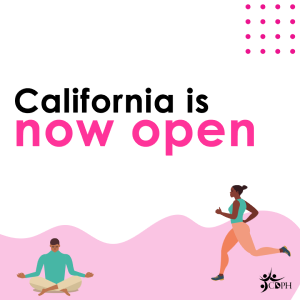
As of June 15, California retired its Blueprint for a Safer Economy.1 California’s economy is now fully open. Restaurants, shopping malls, movie theaters, and most everyday places are operating as normal – with no capacity limits or physical distancing required.2 However, everyone is still required to follow masking guidelines in select settings. Some restrictions also still exist for large events.
Masking is Still Required In Some Settings
Everyone, regardless of vaccination status, is still required to wear masks on public transportation (buses, trains, planes, etc.) and some other places (like hospitals and shelters)3 per CDC guidelines.
People who are not fully vaccinated must still wear masks in all indoor public settings (such as, but not limited to, the grocery store and the movie theater) and should wear masks in outdoor crowded settings when that region is experiencing high covid transmission.
Fully vaccinated4 people may go unmasked in most settings (except public transportation and places like hospitals and shelters). Workers must follow Cal/OSHA rules.
Read our full masking guidance.
Large Events are Subject to Some Restrictions
Some public health measures are still in place for large, or mega events, which include 5,000+ people indoors or 10,000+ outdoors. Think concerts, sporting events, festivals, and conventions. Mega events are high risk for spreading covid-19 because they attract people from around the world, and people gather in crowds. Indoor mega event attendees will be required to confirm proof of vaccination or negative covid-19 status to attend. Outdoor mega event attendees will be strongly encouraged to do so.
What’s Next
California will keep a close eye on covid-19 vaccination and infection rates over the summer and will review these guidelines by September 1, 2021. Learn more here.
1See the full Beyond the Blueprint guidance. Read the Beyond the Blueprint Q&A.
2Local health jurisdictions may impose stricter criteria. In workplaces, employers are subject to the Cal/OSHA COVID-19 Emergency Temporary Standards (ETS) or in some workplaces the CalOSHA Aerosol Transmissible Diseases Standard, and should consult those regulations for additional applicable requirements.
3This includes K-12 schools, childcare and other youth settings, healthcare settings (including long term care facilities), state and local correctional facilities and detention centers, homeless shelters, emergency shelters, and cooling centers.
4Someone is considered fully vaccinated two weeks or more after their second dose of Pfizer/Moderna or two weeks after receiving the single dose J&J vaccine.

